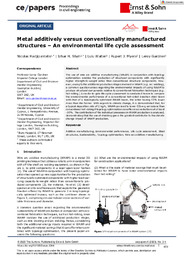Metal additively versus conventionally manufactured structures – An environmental life cycle assessment

View/
Date
2023-09-12ISSN
2509-7075Publisher
WILEYSource
ce/papers – Proceedings in civil engineeringVolume
6Issue
3-4Pages
672-677Google Scholar check
Keyword(s):
Metadata
Show full item recordAbstract
The use of wire arc additive manufacturing (WAAM) in conjunction with topology optimisation enables the production of structural components with significantlyhigher strength-to-weight ratios than conventional structural components. How-ever, owing to the additional production stages involved in WAAM (e.g.arc welding), a commonquestion arises regarding the environmental impacts of using WAAM to produce structural componentsrelative to conventional fabrication techniques (e.g.hot-rolling.) Acradle-to-gate life cycleassessment is conducted herein to compare the environmental performance of a conventional hot-rolled I-section steel beam with that of a topologically optimised WAAM beam,the latter having 53% lower mass than the former.With regards to climate change, it is demonstrated that, for a typical deposition rate of 2 kg/h, WAAM can lead to lower CO2-eq. emissions than conventional hot-rollingiftopology optimisationcan offer mass reductions of at least~50%.The contribution of the individual processes in WAAM production is analysed, demonstrating that the use of shielding gas is the greatest contributor to the climate changeimpact of WAAM production.
Collections
Cite as
The following license files are associated with this item:

